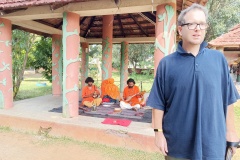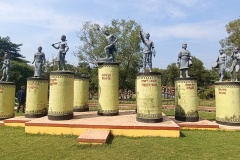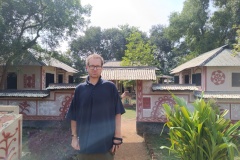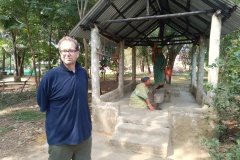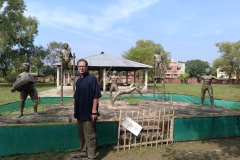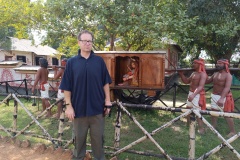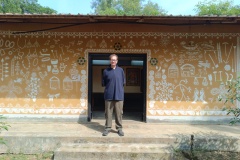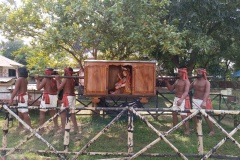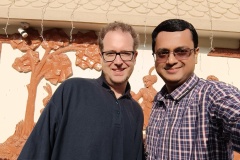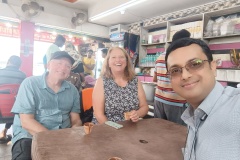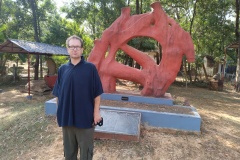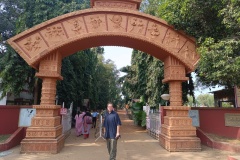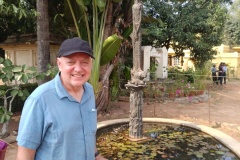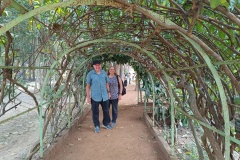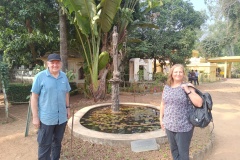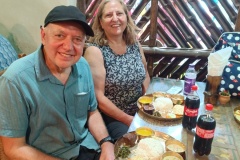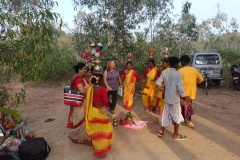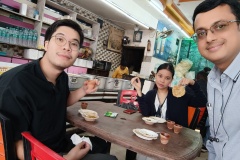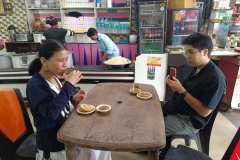Private Guided Tour of Santiniketan

Santiniketan, located in the Birbhum district of West Bengal, India. It is a small town near Bolpur nearly 3 hours from Kolkata. Santiniketan was established by the famous Nobel laureate Rabindranath Tagore. His vision transformed it into a university town, with Visva Bharati University at its fourfold. It has grown to become one of India’s most renowned places of higher learning. Santiniketan is also a world-renowned tourist attraction because Rabindranath Tagore wrote many of his literary classics here; his house is a place of historic importance.
In 1862, Maharshi Debendranath Tagore, while on a boat journey to Raipur, came across a landscape with red soil and meadows of lush green paddy fields. Rows of chhatim trees and date palms charmed him. He stopped to look, decided to plant more saplings and built a small house. In 1863, Debendranath Tagore secured a permanent lease for 20 acres (81,000 m2) of land, adorned with two majestic Chhatim Trees (Alstonia scholaris). This land was obtained from Bhuban Mohan Sinha, the talukdar of Raipur, Birbhum, for an annual fee of Rs. 5. On this land, he constructed a guest house and bestowed upon it the name “Shantiniketan”. Santiniketan means abode (niketan) of peace (shanti). Santiniketan was earlier called Bhubandanga. Over time, this entire region came to be recognized as Shantiniketan and it became a spiritual centre where people from all religions were invited to join for meditation and prayers. He founded an ‘Ashram’ here in 1863 and became the initiator of the Brahmo Samaj.
Later on December 22nd 1901, Debendranath’s son, Rabindranath Tagore started Patha Bhavan, the school of his ideals, whose central theme was that learning in a natural environment would be more enjoyable and fruitful and modelled it on the lines of the ancient gurukul system. After he received the Nobel Prize (1913), the school was expanded into a university in 1921. It was renamed Visva Bharati, its symbolic meaning being defined by Tagore as “where the world makes a home in a nest”. The aim of this educational institute was the quest for truth, blending the methods of learning of the East and West.
Visva Bharati, now more than a hundred years old, is one of the most prestigious universities of India with degree courses in humanities, social science, science, fine arts, music, performing arts, education, agricultural science and rural reconstruction. Kala Bhavan, the art college of Santiniketan, is considered one of the best art colleges in the world. As well as Patha-Bhavan, there are two schools for kindergarten level education known as Mrinalini Ananda Pathsala and Santosh Pathshala, a school for primary and secondary education known as Shiksha Satra, and a school of higher secondary education known as Uttar-Siksha Sadana.
By 1951, Visva Bharati University had become one of India’s central universities. The list of alumni includes Nobel-winning economist Amartya Sen, globally renowned filmmaker Satyajit Ray and the country’s leading art historian, R. Siva Kumar, to name just a few. Many world-famous teachers came to be associated with it, including C.F. Andrews and Alex Aronson. Some of its illustrious students are Gayatri Devi, Indira Gandhi, Satyajit Ray, Abdul Ghani Khan, Sukriti Chakrabarti, and Nobel Laureate Amartya Sen.
Santiniketan is home to Amartya Sen, the 1998 Nobel Prize winner in Economics.
Major Attractions of Shantiniketan
- Brahmo Mandir (Prayer Hall): The Upasana Griha is a prayer hall, constructed in 1891, made of several coloured Belgium glasses with marble steps on all the four side. During evening service on special occasions like 25 December, candle is lit around the prayer hall, and it wears a magnificent look in flickering light. This prayer hall is also named as ‘Kanch Mandir’ in local term (Kanch in Bengali means glass and Mandir is temple).
- Chhatimtala: Here Maharshi Devendranath, the father of Rabindranath Tagore, used to meditate. Prayers are held usually at convocation time. Successful graduates of the Visva Bharati University are presented a branch of five leaves from the Saptaparni trees which are abound in the area.
- Santiniketan (the abode of peace) Griha: The oldest building of Santiniketan. It was built by Rabindranath Tagore’s father Debendranath Tagore. Rabindranath Tagore stayed here as a young boy. When little Rabindranath went to Himalaya, his parents lived here.
- Bichitra: It is also called Rabindra Bhavan, a research centre and museum where the poet’s personal belongings, paintings and editions of his works are exhibited. The replaced Nobel prize is also kept there.
- Uttarayan Complex: The poet lived and worked in the Northern Complex consisting of several buildings: Udayana, Konarka, Shyamali, Punascha and Udichi.
- China Bhavan: A centre for Chinese studies. Natir Puja, a dance drama of Tagore, is painted on its wall under the guidance of Nandalal Bose, a pioneering Indian artist.
- Hindi Bhavan: Department of Hindi Language. There is an important wall mural called “Medieval Saints” made by Binode Behari Mukherjee in the main hall.
- Black House: A mud building known for its relief works done by stalwarts like Ram Kinkar and Prabhas Sen. Usually the final year students of Visva Bharati stay here.
- Patha Bhavan: It is now a secondary school and an example of the traditional Brahmacharya Ashram.
- Kala Bhavan: The College of Fine Arts & Crafts has a museum exhibiting sculptures, frescoes, murals and a library of art books. Look out for sculptures and frescoes of Nandalal Bose, Ramkinkar Baij and Binode Bihari Mukherjee, particularly around Kala Bhavan.
- Sangeet Bhavan: College of Dance and Music.
- Dehali: Rabindranath used to live with his wife Mrinalini Devi in this two storeyed building.
- Shilpa Gram: ShilpaGram, close to the Ballavpur deer sanctuary, is designed very nicely and showcases traditional handicrafts of eastern region (including Bihar, Assam, Orissa, Manipur, Andaman, Jharkhand, et-cetera). Each state is represented by a traditional house with collection of paintings, artifacts, et-cetera.
- Kopai River: Known as “Amader Chhoto Nodi”( Ours’ small river) in many of Tagore’s poems, particularly those for children.
- Khoai Mela: The mela starts from around 15:00 and goes on till about 17:30-18:00 only on Saturdays.
- Amar Kutir: Many handicrafts like cloth, leather, batiks, hand-loomed fabrics are available.
- Basundhara: It is situated at Sonajhuri palli. That offer quality kantha stitchwork in the form of Sarees, Dupattas, et-cetera throughout the year.
- Kankalitala: This is one of the sacred Shakti- Peethas, with a temple, on the bank of the river Kopai.
- Visva Bharati Central Library: It is a paradise for book lovers.
Tour Plan
- Standard Trip Duration: 12 hours (flexible)
- Tour Starts: 07:00 am
- Tour Assistance: Yes
- Professional Tour Guide: Optional
- Driver: Yes
- Refreshments & Packed Drinking Water: Inclusive
- Lunch Break: Yes
- Entry Fees / Camera Charges: Not included. Travelers can pay these fees on the spot, at the entrance.
- Vehicle Parking and Toll Charges: Inclusive
Tour Cost
USD. 150
per guest.
(minimum 2 guests are required or one willing to pay for two)





